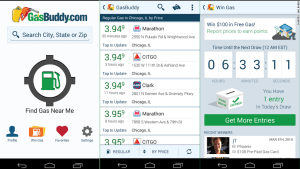GasBuddy: from a friendly gas price whisperer to a data analytics giant

Have you ever felt the frustration of driving down the highway with a freshly filled gas tank only to find out that 2 miles down the road the next gas station had a lower price? Well, GasBuddy is here to help.
Have you ever felt the frustration of driving down the highway with a freshly filled gas tank only to find out that 2 miles down the road the next gas station had a lower price? Well, GasBuddy is here to help.
GasBuddy uses crowdsourcing to report on local gas station prices. Since the website first launched in 2000, GasBuddy has relied on drivers to update price fluctuations sometimes even daily. Similar to Waze, GasBuddy uses maps to locate all the gas stations and an easy interface allows users to click on the station they wish to update. Other users are able to view the data sorted by distance or price, in a list view or in a map view.

Since 2000, GasBuddy has passed milestone after milestone. In 2013 alone, they recorded 2,491,011 new membership signups, with their total user base surpassing 11 million in October. On June 21, the GasBuddy app passed the 30 million download mark, the same day it accumulated its 125,000th “like” on Facebook.
Nowadays, GasBuddy also gets pricing from stations and credit card agreements, but it is the ongoing updating from users what makes the app valuable for other users. The update method is also very desirable. While it is less appealing, dangerous, and in some states illegal to use your phone while you are in the middle of driving, users update GasBuddy while they are waiting for their tank to be filled.
The app incentivizes people to post gas prices by offering a weekly drawing for a $100 gas card. GasBuddy gives users points every time they post prices. They need to report about six or seven gas prices to be eligible for the drawing. Additionally, they continue to be constantly featured in “the best app” lists across different categories. User base has continued to expand. Though the website, GasBuddy.com, still draws more traffic, the number of users who come to GasBuddy through a mobile device should soon surpass those who experience the brand online.
The app still continues to be free however, not only are they driving revenue through advertising but now they are taking advantage of the data generated by both the app and the website. The media site uses data compiled from GasBuddy.com to create averages and other useful statistical information about gas prices nationally and locally. It allows reporters to quickly gather simple statistics, such as benchmark prices, for use in the media.
So what’s next for the company? Jason Toews, one of the co-founders, would like to see GasBuddy develop into a prediction engine. “We want to alert people ahead of time when gas prices are going up, so we’re working on creating an early warning system for people so they can save,” Toews says. Gas prices may be at an all-time low now but back in 2011 when gas hit a high of $4 per gallon, if you were a driver logging 100 miles per day through your job, a couple of cent difference could make a difference in your bottom line. I predict the data being collected by GasBuddy will only continue to become increasingly important across different industries from gas & oil analysts to logistics firms.



Very cool – had never heard of GasBuddy before, but it seems to fit really well into the Waze type of app. As a consumer, what I think is missing from their model is some kind of internal calculator that tells me if it’s worth driving 10 minutes out of the way for a few cents of savings… If I could input my car make and model and indicate my gas mileage, it would be amazing for the app to calculate for example that net of additional driving to a station that’s out of your way, you could save $2.34 on your fill-up.
I also wonder whether gas stations might be interested to use the app information to influence their own pricing decisions — would a competitor under-price a nearby gas station upon getting an update on the app for example?
I’ve used Gasbuddy before, and I used it fervently for about 2 weeks and then stopped because I never won anything and I didn’t want to be the data gathering monkey for the company. I think a huge issue with the app is churn, especially if users don’t believe they will get anything for their effort. My hypothesis is that users download the app but stop using it after a very short time period, especially if they don’t win a gas card in the first 2-3 weeks. If Gasbuddy changed the incentive system they may see a reduction in churn rate. Furthermore, Gasbuddy works better in cities where people drive a lot (L.A. or Houston), but less so in other cities like NYC or SF.
The one issue I have with prediction methods is that it has to be time sensitive. If my tank is low, I can’t wait a week for prices to get lower. However, I would find it valuable if you told me that 5 miles a way is a cheaper gas station of decent quality. But with gas prices as cheap as they are these days people have the time to save the extra penny than they did a few years ago.
I wonder whether the growth of GasBuddy has had an effect on gas prices themselves. With increasing price transparency for both customers and gas station operators, I would suspect that local gas prices are now less likely to differ greatly than before GasBuddy existed. If that is true, GasBuddy would be a great example of how a crowdsourced business is driving greater market efficiency.